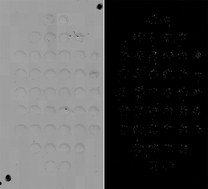(Phys.org)—A trio of researchers at the National Institute of Standards and Technology (NIST) in Maryland has found a way to accurately recreate human fingerprints. The reason for doing so, the team writes in their paper published in the journal Analytical Methods, is to provide a means for testing fingerprints for other chemicals as part of forensics research efforts.
Scientists know that when people work with explosives or illegal substances such as drugs, tiny amounts of those substances are captured in the oils produced in the fingers and are subsequently left behind in fingerprints when those people touch something else. Forensic research has focused on ways to recreate the process in an artificial way to better understand what properties are involved so as to better understand what occurred before, during or after a crime has been committed.
Researchers at NIST are hoping to discover new analysis techniques that will reveal more information about a person who has left fingerprints at a crime scene. By recreating the process in a controlled way, it becomes possible to vary environmental conditions to see what impact they might have on prints that are left behind.
Previous attempts to create artificial fingerprints have revolved around inkjet printing techniques, but have failed due to the oily nature of the materials involved, principally, sebum, the oil that is actually found in human fingerprints. The new method developed by the team at NIST takes a different approach.
The team created a solution by dissolving sebum in heptane to cause it to liquefy, then added particles of an explosive material followed by polyisobutylene to force the particles to remain suspended in the solution. To apply the solution they built a device that has a pneumatically controlled piston inside of a tube with a ball on the end (similar to an ink pen) that allows a controllable amount of the solution to pass through when pressed against a surface. Upon application, the solvents evaporate leaving just the sebum with the suspended particles still in it. In refining the piston-ball configuration, the team has found that they were able to apply the material onto surfaces in pattern shapes that resemble human fingerprints.
More information: Evaluation of a drop-on-demand micro-dispensing system for development of artificial fingerprints, Anal. Methods, 2013, Advance Article, DOI: 10.1039/C2AY26167G
Abstract
Precision micro-dispensing is an evolving technique that has many applications in the scientific and additive manufacturing communities. Here we describe a method for dispensing viscous materials, including the oily substance found in human fingerprints, known as sebum. In this work, a dispense jet system was used to deposit known amounts of sebum onto surfaces to represent an artificial human fingerprint. Ultraviolet-visible spectrophotometry (UV-Vis) and microgravimetry were used to verify the sebum mass loadings of the samples. The dispense jet was capable of printing a viscous sebum mixture as well as a less viscous solution of sebum dissolved in heptane. This method was shown to be repeatable, and UV-Vis was found to be a simple and useful technique for verifying the mass of sebum deposited. This method could be used to prepare artificial fingerprint samples for a variety of applications including the preparation of test materials for emerging trace detection technologies.
Journal information: Analytical Methods
© 2012 Phys.org























